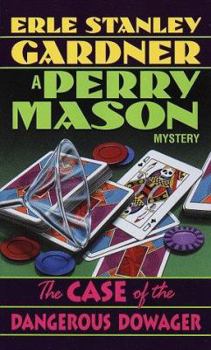Book Overview
Criminal lawyer and bestselling mystery author Erle Stanley Gardner wrote nearly 150 novels that have sold 300 million copies worldwide. Now, the American Bar Association is bringing back his most... This description may be from another edition of this product.
Format:Mass Market Paperback
Language:English
ISBN:0345331923
ISBN13:9780345331922
Release Date:July 1986
Publisher:Ballantine Books
Length:200 Pages
Weight:0.25 lbs.
Customer Reviews
2 ratings
A Fast-Moving Murder Mystery
Published by Thriftbooks.com User , 15 years ago
Perry Mason has a new client. Matilda Benson has white hair and gray eyes, she is a "hard-bitten old hellion". She has enough money to do what she wants. Her granddaughter Sylvia Oxman gambles and has huge debts. Matilda wants to buy them back at face value so Sylvia's husband can't get them as evidence in a divorce and Sylvia won't know who has them. Perry has a scheme to use Paul Drake in disguise. Gambling tables make the most money from angry men who lost (Chapter 3). Perry and Paul fail to recover the debts. Sylvia's husband can get control of a trust fund if a judge rules against Sylvia. But there is a new opportunity to recover the debts. Della Street asks Perry to avoid that gambling ship. When Perry visits Sam Grieb's office he finds his body (Chapter 5). He warns Sylvia, then makes a payoff. [Evidence tampering?] Duncan returns with Perkins, who searches Perry for anything that may be missing. Matilda tells Perry what she saw Sylvia do (Chapter 6). Do gambling casinos have cheap dinners to attract customers (Chapter 7)? Bert Custer worked in a hardware store and sold lots of guns; he knew what looked like a .39 blue-steel automatic. Will Perry get a subpoena? Paul Drake reports on events (Chapter 9). Perry and Paul learn more facts about Arthur Manning (Chapter 10). Perry has Sylvia's account and reads Frank Oxman's statements (Chapter 11). Drake's operative tells his story (Chapter 12). Perry visits Frank Oxman (Chapter 13). We learn what happened to Matilda (Chapter 14). But the police arrive to bring them in for questioning. As in old-style murder mysteries all the people are gathered together for the finish (Chapter 15). Did you figure out the solution by now? The person who told a lie is the murderer. Will the murderer walk into a trap? Chapter 16 ties up the loose ends. Perry skated very close to the line in this case. This was his style in the early novels. Can a woman get a divorce when her husband makes a willfully false statement about her?
The whole is a bit less than the sum of its parts
Published by Thriftbooks.com User , 23 years ago
Background: The stylistic heritage of the Perry Mason mysteries is the American pulp magazines of the 1920s. In the early Mason mysteries, Perry - a good-looking, broad-shouldered, two-fisted, man of action - is constantly stiff-arming sultry beauties on his way to an explosive encounter that precipitates the book's climactic action sequence. In the opening chapters of these stories, Gardner subjects the reader to assertive passages that Mason is a crusader for justice, a man so action-oriented he is constitutionally incapable of sitting in his office and waiting for a case to come to him or to develop on its own once it has - he has to be out on the street, in the midst of the action, making things happen, always on the offensive, never standing pat or accepting being put on the defensive. These narrative passages - naïve, embarrassingly crude "character" development - pop up throughout the early books, stopping the narrative dead in its tracks, and putting on full display a non-writer's worst characteristic: telling the reader a character's traits instead of showing them through action, dialogue, and use of other of the writer's tools.Rating "Ground Rules": These flaws, and others so staggeringly obvious that enumerating them is akin to using cannons to take out a flea, occur throughout the Gardner books, and can easily be used (with justification) to trash his work. But for this reader they are a "given", part of the literary terrain, and are not relevant to my assessment of the Gardner books. In other words, my assessments of the Perry Mason mysteries turn a blind eye to Erle Stanley Gardner's wooden, style-less writing, inept descriptive passages, unrealistic dialogue, and weak characterizations. As I've just noted, as examples of literary style all of Gardner's books, including the Perry Mason series, are all pretty bad. Nonetheless, the Mason stories are a lot of fun, offering intriguing puzzles, nifty legal gymnastics, courtroom pyrotechnics, and lots of action and close calls for Perry and crew. Basically, you have to turn off the literary sensibilities and enjoy the "guilty" pleasure of a fun read of bad writing. So, my 1-5 star ratings (A, B, C, D, and F) are relative to other books in the Gardner canon, not to other mysteries, and certainly not to literature or general fiction."The Case of the Dangerous Dowager": B-This Perry Mason mystery has a promising premise and opens nicely, but falters in the latter stages, never really bringing the disparate elements of the mystery together in a very satisfying way. The central problem with the story is that the mystery itself is too weak - Gardner fails to divert our attention from the crucial clue - the timing of the visits to the office where the murder is committed - and we realize who the guilty party is as soon as Perry himself does.The situation is a good one, one that Gardner uses with outstanding results in some of the later entries





